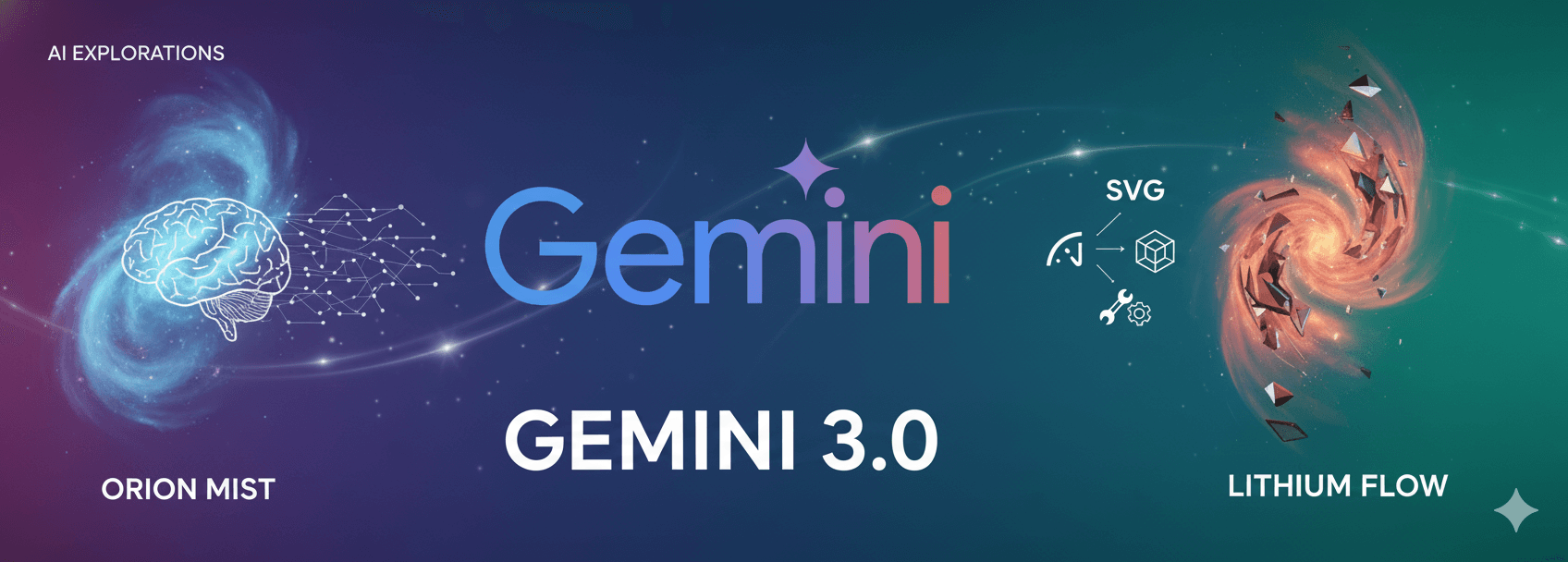
Gemini 3.0's Unconfirmed Models: A Look at Orion Mist and Lithium Flow on LM Arena
Decoding Gemini 3.0's Mystery: Orion Mist and Lithium Flow on LM Arena
New leaks on the LM Arena suggest Google is testing unconfirmed Gemini 3 models named 'Orion Mist' and 'Lithium Flow'. The AI community is alight with discussions about these two new, unconfirmed models.
These aren't just any new models; many believe they're a sneak peek into what Google has planned for Gemini 3.0. It's exciting to imagine what advancements they could bring to the table, especially for those of us building web experiences, AI-driven tools, and automation systems.
I've been closely following Google's AI journey, and the release of new Gemini 3.0 checkpoints always piques my interest. I already reviewed the previous Gemini checkpoints like X58, 2HT, and ECPT, and the latest Gemini 3.0 checkpoint Riftrunner.
I'm here to help you navigate the speculation, diving deep into their observed characteristics, early performance insights, and the discussions happening across the community. My goal is to break down what makes Orion Mist and Lithium Flow so intriguing and how they might shape the future of smart automation.
I believe understanding these developments is crucial for anyone looking to stay at the forefront of AI capabilities, whether you’re a startup founder, a small business owner, or a content creator. Let's explore what these potential Gemini 3.0 checkpoints reveal about Google's direction and what it could mean for your next project.

What Are Orion Mist and Lithium Flow?
When I first saw Orion Mist and Lithium Flow pop up on LM Arena, I immediately wondered what Google was cooking up. Many in the AI world, including myself, believe these are unconfirmed checkpoints for Gemini 3.0. It's like catching a glimpse of a secret project before its big reveal, offering us a peek into the cutting-edge of smart automation.
We can differentiate these two models by their apparent roles and specialized functions:
- Lithium Flow: This appears to be the foundational model, the core intelligence at play. Think of it as the robust engine that powers the overall system, responsible for fundamental language understanding and generation tasks.
- Orion Mist: This seems to be an iteration built on Lithium Flow, but with added capabilities like enhanced grounding or search tool integration. This means Orion Mist can more effectively connect its internal knowledge with external, real-time information, making its responses more accurate and contextually rich.
This distinction is really important. Why? Because it tells us about Google's focus: building powerful base models and then creating specialized versions tailored for practical, real-world applications. It makes me think about how different components of AI models work together to create a more comprehensive and versatile system, capable of handling a broader range of complex tasks.
The names themselves, Orion Mist and Lithium Flow, even hint at Google's internal naming conventions for past Gemini iterations. This consistent pattern adds a lot of weight to the idea that these are indeed part of the Gemini 3.0 family. Understanding their individual roles gives us a clearer picture of where Google is steering its smart automation development, aiming for both raw power and specialized utility. If you're curious about how these complex AI systems are built and refined, you can learn more about the intricacies of AI model development.
What does 'grounding' mean in the context of AI models? Grounding in AI refers to connecting a model's abstract knowledge to real-world data or external tools, ensuring its responses are accurate and contextually relevant. This capability is key for AI models to move beyond theoretical understanding to practical, reliable interactions, making them much more valuable in everyday applications.
Early Performance Insights and Community Reactions
I've been closely watching the early tests of Orion Mist and Lithium Flow on LM Arena, and the results are quite interesting. For certain tasks, these models generally show better performance than the 'ECPT' checkpoint, which was another early iteration we observed. This indicates a clear progression in Google's development efforts.
Here’s where they seem to shine, demonstrating notable improvements:
- SVG generation: They create scalable vector graphics with impressive detail and accuracy, which is crucial for designers and developers.
- 3D rendering: From generating objects like a detailed Pokeball to complex Minecraft scenes, their ability in 3D rendering is a significant step forward.
- General and math questions: They handle complex queries and mathematical problems with improved accuracy and reasoning, which is a core strength for any advanced AI.
That's a clear step forward in those areas. However, it's not all praise. Some content creators and users have pointed out that these models might feel a bit 'nerfed' when compared to earlier, unofficial previews like 'X28' and '2HT'. For instance, I noticed that floor plan generation wasn't as impressive as I'd hoped, which was a strong point for some previous checkpoints. This kind of mixed feedback is common in early testing phases and provides valuable data.

This mixed feedback is actually quite telling. It suggests that these models might be in an optimization phase, balancing raw capability with other important factors like efficiency and stability. Why do some AI models seem to perform better in certain tasks than others? It often comes down to their specific training data, the architectural choices made during development, and the optimizations applied. I think this mixed feedback gives Google valuable insights into where to fine-tune before a wider release, ensuring the final product meets a broad range of user expectations. It's a natural and essential part of the development cycle for advanced smart automation.
Are these 'nerfed' models a sign of reduced overall capability? Not necessarily. The term 'nerfed' often refers to models optimized for deployment, which might involve trade-offs in raw power for efficiency and scalability. It's about finding the sweet spot for broad accessibility and practical use, rather than maximizing every single benchmark in a lab setting.
The "Nerfed" Theory: Optimized for Deployment?
One theory I find particularly compelling is that Orion Mist and Lithium Flow might be more finely quantized versions of Gemini 3.0. What does that mean in simple terms? It suggests they've been optimized for efficient deployment, potentially operating with slightly reduced 'thinking budgets' compared to earlier, less optimized versions. This approach prioritizes scalability and broader user access over raw, unconstrained power, making the technology more practical for everyday use.
When you optimize an AI model for deployment, you often make strategic trade-offs. You might sacrifice a tiny bit of raw processing power in highly specialized tasks to ensure the model can run quickly and affordably for millions of users across various devices. It's a common and necessary practice in the world of smart automation development, especially when moving from experimental prototypes to production-ready systems. I see this as Google preparing for a wide release, making sure the technology is not just powerful but also practical, accessible, and sustainable.
Here are the key priorities for deployment optimization and their potential trade-offs that I've observed:
Priorities:
- Efficiency: Achieving faster processing speeds and lower computational costs, which is vital for large-scale applications.
- Scalability: Ensuring the model can handle a large number of users and requests simultaneously without performance degradation.
- Wider User Access: Making the model available to a broader audience by reducing hardware requirements and operational costs.
- Potential Trade-offs:
- Slightly lower "thinking budgets": The model might allocate less intensive computational effort to extremely complex, niche tasks that require extensive deep reasoning.
- Reduced raw power: In some very specific, less critical areas, there might be a minor, almost imperceptible decrease in performance compared to unoptimized, research-focused versions.
Another strong point I've observed is their focus on tool-calling capabilities. This is absolutely crucial for real-world AI applications. A model that can effectively interact with external systems, APIs, and tools is far more useful than one that just generates text in isolation. It's about making AI truly actionable and integrated into workflows. Understanding these optimization strategies helps us appreciate the engineering behind these powerful systems and how they're being shaped for practical impact. You can explore more on AI optimization.
What are 'thinking budgets' in AI models? 'Thinking budgets' informally refer to the computational resources and time an AI model is allocated to process information and generate responses, impacting its complexity and depth of reasoning. It’s a way to conceptualize the balance between performance and resource consumption.
What's Next for Gemini 3.0?
The constant stream of new checkpoints like Orion Mist and Lithium Flow keeps us all guessing and excited about what's next for Gemini 3.0. While these models show clear improvements in specific areas compared to some previous iterations, the anticipation for an official, fully-fledged Gemini 3.0 release is still building. I know I'm not alone in eagerly awaiting it!
From what I've seen, Google's focus remains squarely on robust tool-calling capabilities and striking a careful balance between raw power and deployment efficiency. This tells me they're aiming for a model that's not just smart but also incredibly practical and widely usable. I believe the official release will emphasize real-world applications and seamless integration with other systems, making it a valuable asset for various industries.
What are my predictions? I expect Gemini 3.0 will further refine its ability to understand complex queries and interact with external data sources more smoothly, leading to more nuanced and helpful responses. I'm personally most excited to see how these models will empower creators and businesses to build even more sophisticated smart automation tools, streamlining processes and unlocking new possibilities. The future of AI is all about making powerful technology accessible and useful in our daily lives, and I think we're on the cusp of some truly exciting advancements in this space.
Will Gemini 3.0 be available to the public soon? While there's no official release date, the continuous appearance of new checkpoints suggests that Google is actively developing and refining Gemini 3.0, indicating a potential release in the near future. This ongoing development is a positive sign for the AI community and those eager to harness its capabilities.
My Take on the Future
As we continue to monitor the developments of Orion Mist and Lithium Flow, it's clear that Google is pushing the boundaries of smart automation. These unconfirmed models offer a fascinating glimpse into the potential capabilities of Gemini 3.0, balancing raw power with the practicalities of deployment. I'm excited to see how these advancements will empower developers, creators, and businesses to build even more sophisticated and efficient AI-driven solutions. The journey of AI development is constantly moving forward, and I'm here to help you stay ahead of the curve, translating complex tech into practical insights you can use.
Did you find this article helpful?